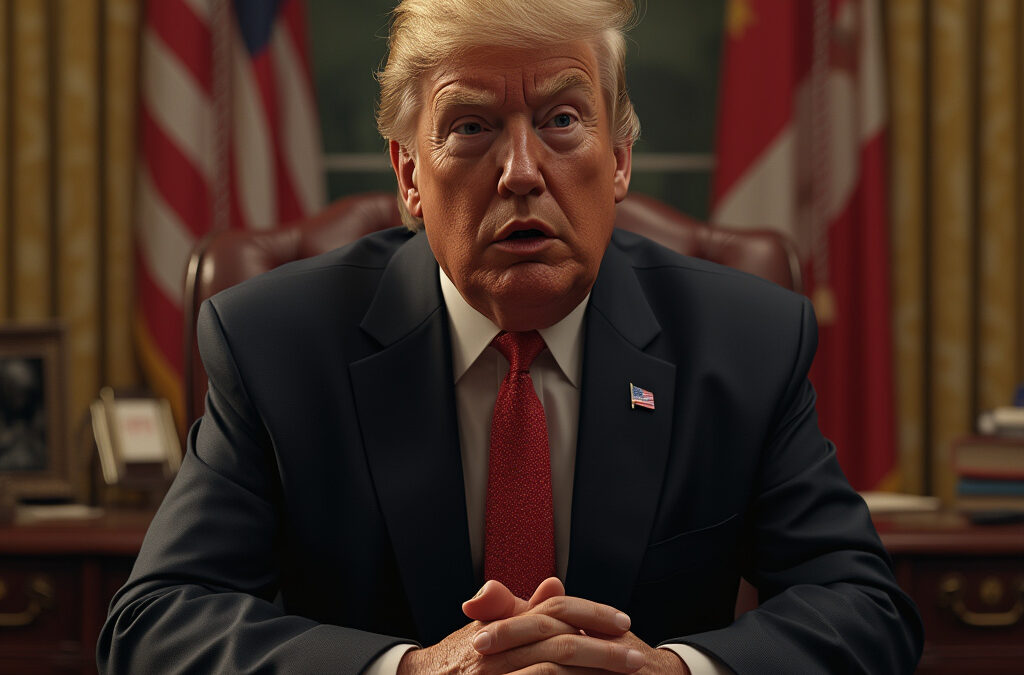“`html
Tariff Tuesday: Trump Says He’ll Hit Mexico, Canada, and China With Duties
President Donald Trump has announced plans to impose significant tariffs on imports from Mexico, Canada, and China, starting on March 4, 2025. The move, revealed in a post on Truth Social, marks a major escalation in U.S. trade policy.
Under the plan, Canada and Mexico will face a 25% tariff on their imports to the U.S. China, meanwhile, will see an additional 10% tariff, doubling the existing 10% universal tariff currently in place.
Trump justified the tariffs by pointing to concerns over illicit drug smuggling, particularly fentanyl, into the United States. He claims the tariffs will pressure these countries to crack down on drug trafficking.
The tariffs will apply broadly, with few exceptions. Canadian energy resources will receive a lower 10% tariff, offering some relief to the energy sector.
Economic concerns are already mounting. Experts warn the tariffs could worsen inflation and harm key industries, such as the auto sector, which relies heavily on cross-border trade.
There are also fears of retaliation from affected countries. Such measures could further strain international trade relations and spark a cycle of escalating tariffs.
Trump has hinted at even harsher measures if these countries respond with retaliatory actions. He also floated the idea of imposing tariffs on European countries and targeting specific products like autos, computer chips, and pharmaceuticals.
The president is using the International Emergency Economic Powers Act (IEEPA) to implement these tariffs. This marks the first time a U.S. president has invoked this law for such a purpose.
The use of IEEPA allows for rapid implementation with minimal oversight, reflecting Trump’s increasingly aggressive approach to trade policy. This strategy extends beyond traditional trade disputes, targeting broader foreign policy issues.
As the March 4 deadline approaches, businesses and consumers alike are bracing for the potential impact. The tariffs could reshape global trade flows and add pressure to an already fragile economic landscape.
Stay tuned for further updates as this developing story unfolds. Read more here.
“`
Details of the Tariff Plan and Its Potential Implications
The tariff plan includes specific details on how the duties will be applied. Imports from Canada and Mexico will face a 25% tariff, while China will see an additional 10% tariff on top of the existing 10% universal tariff, effectively doubling it to 20%.
Canadian energy resources will receive a lower tariff rate of 10%, providing some relief to the energy sector. However, the tariffs will apply to a wide range of products, with few exceptions, impacting various industries and consumers.
These new tariffs will be applied in addition to any existing duties or fees on covered imports, further increasing the financial burden on imported goods. The auto industry, in particular, is expected to be heavily affected due to its reliance on cross-border trade.
Trump has indicated that he may increase tariffs further if Canada, Mexico, and China retaliate against these measures. He has also mentioned the possibility of imposing a 25% tariff on European countries and separate tariffs on specific products such as autos, computer chips, and pharmaceutical drugs.
The president is using the International Emergency Economic Powers Act (IEEPA) as the legal basis for these tariff orders. This marks the first time a U.S. president has used this act to impose tariffs, allowing for rapid implementation with less need for investigations or oversight.
This approach reflects a significant shift in U.S. trade policy, with Trump adopting a more aggressive stance on using tariffs as a tool to address various foreign policy disputes, extending beyond traditional trade concerns.
As the March 4, 2025, deadline approaches, businesses and consumers alike are bracing for the potential impact. The tariffs could reshape global trade flows and add pressure to an already fragile economic landscape.
Stay tuned for further updates as this developing story unfolds. Read more here.
“`html
Conclusion
President Trump’s announcement to impose significant tariffs on imports from Mexico, Canada, and China marks a bold and controversial shift in U.S. trade policy. With tariffs set to take effect on March 4, 2025, the move aims to address concerns over illicit drug trafficking but raises serious economic and diplomatic implications. The 25% tariffs on Canada and Mexico, along with an additional 10% on Chinese imports, could exacerbate inflation, disrupt industries like automotive manufacturing, and strain international relations. The use of the International Emergency Economic Powers Act (IEEPA) underscores the administration’s aggressive approach, bypassing traditional oversight mechanisms. As the deadline approaches, businesses and consumers are bracing for impact, while global markets watch closely for potential retaliation and further escalations.
Frequently Asked Questions (FAQs)
What countries are affected by the new tariffs?
Mexico, Canada, and China will be subject to the new tariffs announced by President Trump.
What are the tariff rates for each country?
Canada and Mexico will face a 25% tariff on their imports to the U.S., while China will have an additional 10% tariff, doubling the existing 10% universal tariff to 20%.
Why is President Trump imposing these tariffs?
The tariffs are primarily aimed at pressuring these countries to address illicit drug smuggling, particularly fentanyl, into the United States.
Which industries will be most impacted?
The automotive industry is expected to be heavily affected due to its reliance on cross-border trade. Other industries and consumers may also face increased costs due to the broad application of the tariffs.
What legal authority is being used to implement these tariffs?
The tariffs are being implemented under the International Emergency Economic Powers Act (IEEPA), allowing for rapid implementation with minimal oversight.
Could there be retaliation from the affected countries?
Yes, there are concerns that Canada, Mexico, and China may retaliate, potentially leading to further trade disruptions and economic strain.
“`

